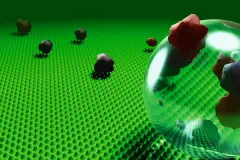
We need your consent to load YouTube.
We use a third-party service to embed video content and make it available to you. By clicking “Accept”, you consent to your data being processed by YouTube in accordance with our CMP. You can find out more about the service by clicking “More information”. You can withdraw consent with effect for the future at any time.
What’s behind biomimetics at Sto?
The idea of using nature intelligently
Are you proud, Mr Barthlott?
40 years ago, a young botanist made an extraordinary discovery in a greenhouse in Heidelberg: the leaves of the lotus plant clean themselves. This microtexture has been used as the inspiration for many surfaces within technical applications. In the form of our Lotusan® facade paint, it protects buildings against dirt and moisture, for example. The young researcher who made the discovery all those years ago was Willhelm Barthlott, who is now a retired Professor. In his free time, he still likes to visit botanical gardens all around the world – and observe the lotus effect whilst he's there.
-

Willhelm Barthlott is now a retired Biology Professor. Mr Barthlott, how did you discover the lotus effect?
It happened back in the 70s when I was a doctoral student and research assistant in Heidelberg. The first scanning electron microscopes had just been released. I found them fantastic because they meant that I could identify and systematise plant microstructures. I could see, for example, that cacti are related to carnations and so on.
So I would go and collect leaves from the greenhouses. If you want to get decent images using an electron microscope, the leaves have to be clean. That means no mud, dust, or crusty irrigation water residue. And that's when I noticed that I didn't have to clean some of the leaves. Yet they had all been next to one another in the same greenhouse.
This was down to the self-cleaning effect of the lotus plant – a complicated microtexture which causes water and dirt to simply roll off.
You won a lot of prizes for the discovery of the lotus effect. Why was it so well received?
Because it was completely unexpected. No other scientist before me had noticed the lotus effect. And that includes the biologists and the physicists, who just had a theory but no concrete surface or product.
The commercial potential of the lotus effect is huge given that what I discovered is so effective and technically relatively easy to apply to surfaces across a wide range of industrial fields. Not to mention that it is relevant in terms of environmental concerns because it can be used to replace a lot of toxic substances. Plus, it can be visually represented to great effect.
Why was it important that your research can be visually represented to great effect?
Because it meant that we got a lot of television coverage. Science journalist Ranga Yogeshwar played a huge role from the very beginning and, in fact, I am still in contact with him to this day. At the time, he had just finished studying Physics in Aachen and was already working for German broadcaster WDR. He just kept on reporting on the lotus effect: in the Lufthansa magazine, then on “Quarks & Co” and the programme called “Wissen vor Acht” just before the news, and on Galileo.
This made other broadcasters, such as RTL, Deutschlandfunk, ORF, BBC, and Arte, follow suit. And then within the space of three months, industrial players approached us, including the likes of BASF, Bayer-Leverkusen, Degussa-Evonik, Erlus, and Procter & Gamble. But the most important one of all was a company called Ispo, which later became Sto.
-

A contradiction in terms: nothing can stick to the microtexture of the lotus leaf. The media attention was incredible. But before you got to that stage, you had to wait almost 20 years before being really accepted in the world of science and research...
No fewer than five big journals rejected our research articles. They were mostly physicists. They wrote things like: “The so-called lotus effect only exists in the fantasy of the author”. I got so angry about this. Many years later, one of those journals called me back because they were conducting research for a background article about this important discovery. And I simply replied: “Well it would have been better if you had just published the original article when I sent it to you!”
Why was it so difficult?
Because the lotus effect is so unusual. It is really surprising when you get a lotus plant all dirty and yet the dirt just rolls off. A rough surface that nothing can stick to is a contradiction.
When I first started back in 1975, nobody had thought about biomimetics or considered all the incredible things that nature can do. It's a relatively new field of research. For a long time, I didn't quite realise exactly what I had discovered. At first I thought that I had come across something new in the field of biology. But I had no idea that the physicists and material scientists were yet to find the lotus effect.
Once I had made my discovery, it took around 20 years for the discussions to get going. For example at an institute for surface physics. By that point I was a Professor in Berlin. The answer was always the same. “We can't comprehend that at all. It can't be anything to do with physics. In fact, it just doesn't work in line with physics. It must be somehow related to biology." They just didn't understand the unexpected principle.
And then we started to produce prototypes. Polymer surfaces with a complex water-repellent microarchitecture. And it worked.
“The so-called lotus effect only exists in the fantasy of the author”
Many scientists were sceptical when Willhelm Barthlott discovered the lotus effect. It was only recently, many years later, that the American journal Botany One reported that its 1997 publication on the lotus effect was in fourth place in the list of works quoted most in scientific journals worldwide in the past 20 years: Google Scholar cites almost 6000 academic publications. Searching for “Lotus effect” on Google returns a few million hits.
-

And ideas based on nature keep making their way to Sto's Development Laboratory. Sto has taken the principle of biomimetics further. StoColor Dryonic facade paint is another example of drawing inspiration from the natural world. Are you proud?
Of course, I am still most proud of Lotusan. But I am happy that companies have been working on this idea because they don't all respond in the same way.
We have to remember that, unlike industrial companies, nature has had millions of years to evolve. A targeted approach needs to be pursued here. It would not have been possible to identify the property of the lotus effect when working on a specific research project because nobody knew about it before.
Sto realised very early on that biological constructions and principles held huge potential for technology, especially taking into account concerns about the environment. It really is a prime example amongst German companies.
-
Biomimetics. Our step ahead.

At Sto, we have been developing products based on the most efficient solutions from nature for 20 years. Our inspiration: 3430 million years of evolution – constant optimisation through further development. The benefit to you: radiant colour intensity, lasting UV and weather protection, facades that clean themselves, and a longer lifecycle for your buildings. We offer cost-effectiveness and ecology combined. This is what we mean by Building with conscience.
-
How a new generation of paints protects itself

Facade paints in our iQ – Intelligent Technology generation have special properties, with their surfaces protecting themselves against rain, soiling, fading, heat, and so much more. And there is no sign of biocidal film protection. Here at Sto, we have more than 160 employees working on environmentally friendly innovations like this in our Research and Development department. A whole three per cent of our turnover is allocated to this area.
We need your consent to load the contact form!
We use a third-party service to embed contact forms and make it available to you. By clicking “Accept”, you consent to your data being processed by Salesforce Marketing Cloud Account Engagement in accordance with our CMP. You can find out more about the service by clicking “More information”. You can withdraw consent with effect for the future at any time.





